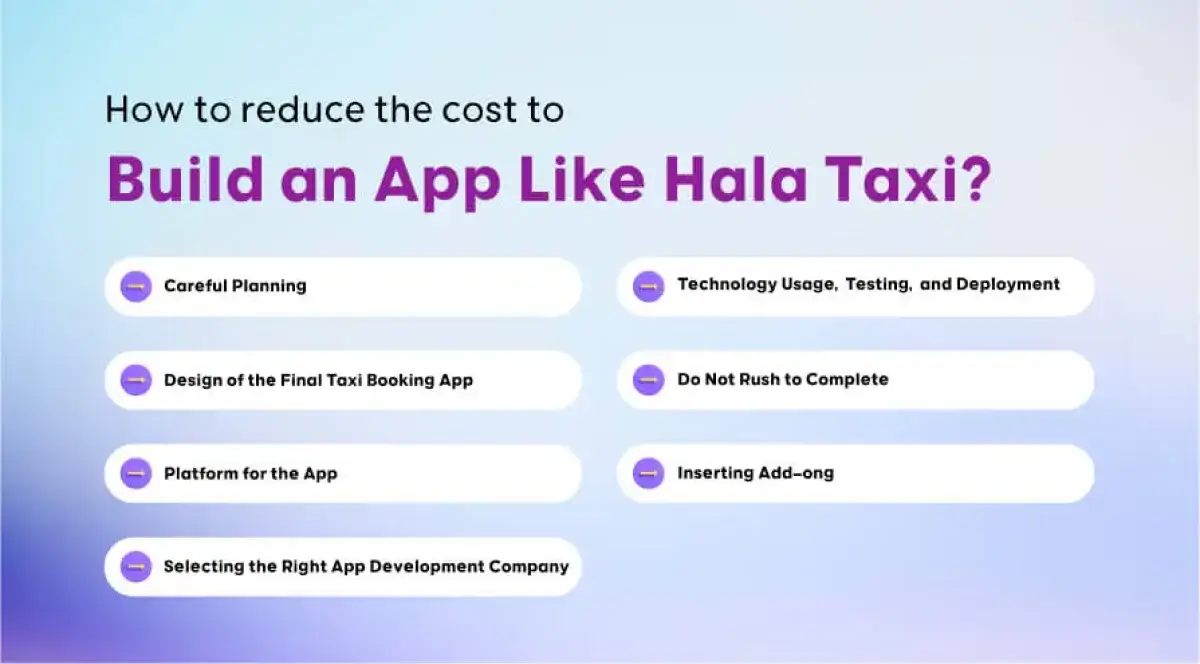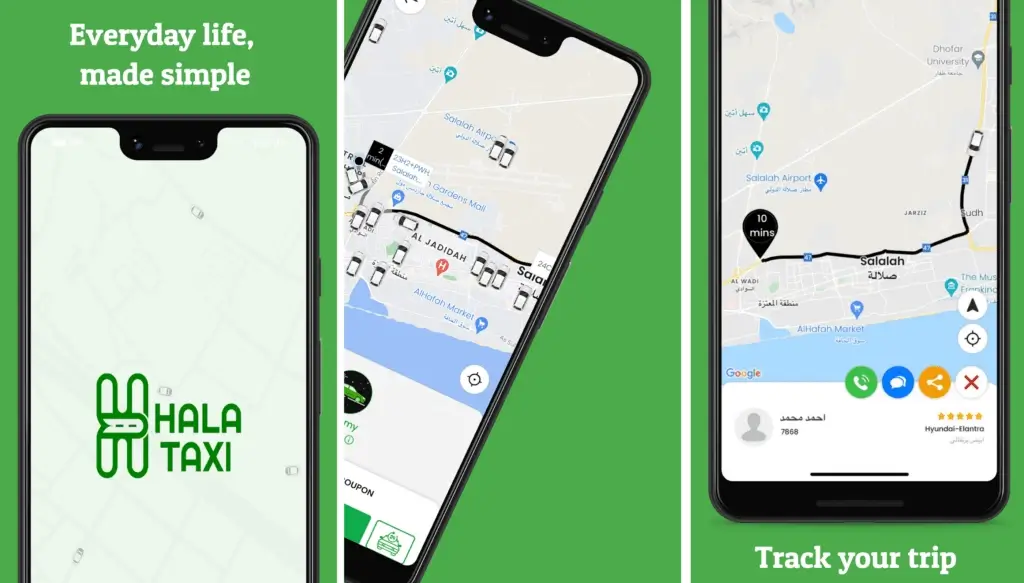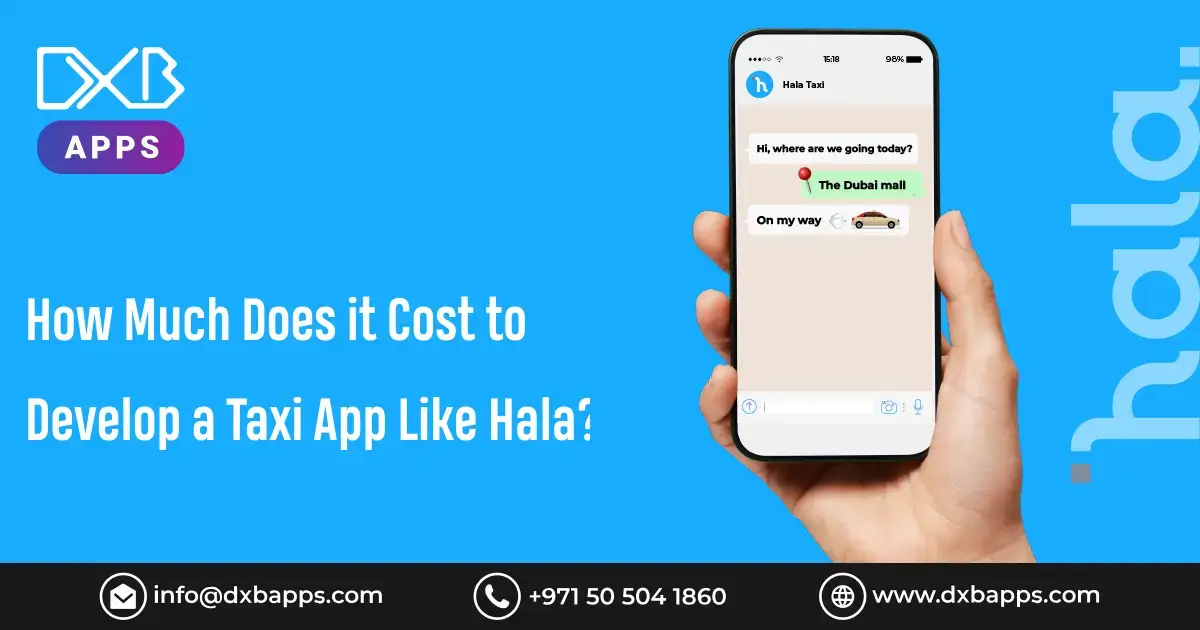With the era of fast urban transport today, companies like Hala Taxi have revolutionised the transport medium for people. As Dubai is growing and drawing millions of residents and tourists, there has been a humongous demand for secure, easy, and efficient transport mediums. Hala Taxi is one of the prominent industry players, an app marrying traditional taxi services with modern technology to deliver a seamless experience.
Furthermore, if you need to develop a Hala Taxi-like taxi application, the question you must address is the total cost. The price of developing a taxi application remains difficult to establish since numerous elements, such as functionality requirements and development platform, design approach, and team expertise, strongly influence the total cost. Here, in this blog, we are going to describe those factors so that you will understand how much it would cost to develop an app like Hala in the year 2025.

How Hala taxi Apps are Performing Well in 2025?
Cab apps revolutionized the whole way of mobility worldwide between cities. Among the very famous cab apps in Dubai is Hala Taxi, and its tale is one of conventional disruption of the taxi business and offering customers and drivers a seamless and easy experience. Forward to 2025, taxi apps such as Hala App Taxi are performing well due to reasons as diverse as growing demand for convenience to the continued revolutionizing of mobility in cities. Such taxi apps are transforming the transport landscape.
1. Increasing Demand for Convenient Transport
Urbanisation sees a large requirement for trouble-free, simple-to-use transportation. With fast and active cities such as Dubai, citizens as well as visitors equally require swiftness as well as comfort in moving along without lining up to hire a taxi or navigating parking hassles.
Hala Taxi and similar companies have fully fulfilled this mandate through on-demand service, in which the riders can order a ride with a tap. Pre-booking pickup, live exposure, and mobile wallet convenience in payment have maintained mobility as uncomplicated as possible.
2. Transparent and Reasonable Pricing
Price transparency is never an issue with experienced travelers used to standard taxi fares. An estimated fare is achieved if one books a ride on Hala. This type of pre-payment fare system not only fosters confidence but also elimination miscommunication via the utilization of standard taxis.
Second, dynamic pricing software is employed by Hala Taxi in a way that prices are set in real-time demand. This aspect provides drivers and riders with reasonable fares, thus making it appealing to value-for-money-conscious customers. The other market leaders, Uber and Careem, have also taken the same direction of prices, but since Hala has aligned itself with the Dubai Taxi Corporation (DTC), it has local recognizability and regulatory trust.

3. Easy User Experience
Ease of use is yet another among the best reasons that other people like Hala Taxi Dubai app and others are doing great in the year 2025. Each one of these apps provides a smooth experience each time, thus making the whole process of booking a taxi fast, simple, and convenient.
From smooth booking of rides and natural interfaces to secure payments within the app, consumers are making ordering rides simpler on mobile devices. With natural elements and simple-to-follow directions, Hala and similar companies offer a smooth experience that gains new customers and repeat customers as well. All such emphasis on convenience and ease has turned the app viral among technologically enabled as well as conventional customers.
4. Local Government and Legislative Integration
Relative to global behemoths Uber and Lyft, Hala is fortunate to be heavily rooted in regional transport networks. Hala Taxi is a joint venture between a ride-hailing company and the Dubai Taxi Corporation (DTC), well within the grasp of regional regulation. The agreement gives Hala the respectability and support it requires to battle in Dubai, which has enormous emphasis on regulation and consumer protection.
Integration with government-owned taxi fleets is another area of competitive advantage for Hala. It offers the best of both worlds—the comfort and familiarity of an established public transport system and the latest, app-based technology.
5. Focus on Sustainability and Green Initiative
As the world turns green, so are its cities embracing greener means of transportation. Hala Taxi also defied the trend by introducing green cars to their fleet. It is particularly useful in the case of Dubai city, which wishes to encourage greener rides in the transport industry.
Hala has added electric and hybrid cars (EVs) to its fleet, which not only saves the release of carbon but also functions as a green point of sale advantage to clients. They are so Dubai Clean Energy Strategy 2050, whereby Dubai will be the least carbon city in 2050. Word starts being heard regarding traveling the green way through such cleaner taxis, Hala is the forward move.
6. Safety Features and Real-Time Tracking
Customer safety is never second on the road. Hala Taxi has ensured customer safety from harm through real-time tracking of rides, prompt assistance in case of an emergency, and authentic verification of drivers.
Real-time tracking gives not only the guarantee of being able to trace the route of the ride but also the relief that there will always be someone to lend a helping hand in case anything goes amiss. Secondly, it offers ride-sharing with a relative or a friend, and that provides added security for users. It has been one of the key contributory elements towards its popularity and growth in the number of users.
7. Convenience to Visitors
One of the largest cities in the world, Dubai, is one of the leading tourist cities. Millions in millions visit Dubai annually. Traveling around a city of a foreign nation can be challenging for a visitor. Taxi ride-hailing apps such as Hala have the convenience benefit that taxi services can never provide.
With the convenience of booking a ride, seeing where the driver is, and paying in a credit card or their own currency at home, riders are finding Hala to be a wonderful and efficient alternative. The language feature of the app also greatly helps foreign tourists.
With all those advantages, no wonder that we are witnessing orders of taxi apps on the rise. But how do you create an application as awesome as the likes of Hala Taxi?
Dream of making a favorite taxi enterprise such as Hala Taxi? Achieve high-class application building with us and rule the taxi business market in the UAE!
Key Features of a Taxi App Like Hala
While developing a Hala-like Dubai taxi app, there are a few functionalities that require addition to the app framework. They not only provide satisfaction to the users but also facilitate the ease of the process to the drivers as well as for the fleet management. Below are the most essential features that should be present in a successful UAE taxi app:
User Registration and Profile Management:
The user should be able to register, log in, and update his/her profile with ease.
Ride Scheduling and Booking:
Simple-to-use interface for scheduling pickup and booking rides, and selecting ride types (e.g., economy, premium).
Real-time GPS Tracking:
Allows users to track their ride in real-time and drivers to drive efficiently.
Fare Calculation and Payment Gateway Integration:
Simple fare models and smooth payment gateway integrations for different modes of payment.
Ratings and Reviews:
Allow users to rate drivers and provide feedback.
Driver Profile Management:
Allow drivers to claim their profile, view earnings, and accept ride offers.
Admin Dashboard:
Admin back-end dashboard for ride assignment management, driver sign-up, payment, etc.
Notifications:
Push notification to the user for ride status, offers, or updates.
Multiple Language Support:
The platform requires the capacity to serve numerous users centered in the metropolitan areas of Dubai.
Cost Breakdown: How Much Does It Really Cost to Develop a Taxi App Like Hala?
The development expenses for a Hala Taxi-style application can change substantially depending on the software complexity, along with its Android and iOS platforms, and the development site and implemented features. The application development process consists of multiple phases, costing a total that can be explained as follows:
1. Initial Development Costs:
- Type of App: Basic, Mid-Level, or Advanced.
- Platform Choice: Android, iOS, or both (cross-platform).
- Design Requirements: Custom design with animation and interactive features or off-the-shelf design.
Estimated Cost Range:
Basic App: AED 100,000 – AED 300,000.
Mid-Level App: AED 400,000 – AED 800,000.
Advanced App: AED 900,000 – AED 1,400,000.
Basic apps include standard booking and payment functionality, but the mid-level application provides ride-sharing abilities with expanded features and integration with multiple languages and user feedback functions. The premium application level would include artificial intelligence capabilities, together with machine learning functions, along with custom features.
2. Development Timeline:
The timeline depends on the features and platform selected:
Basic App: 3 to 4 months.
Mid-Level App: 5 to 7 months.
Advanced App: 8 to 12 months.
Variables That Affect Timeline
- Third-Party Integrations: Organizations need additional time to connect their system through a payment gateway or mapping APIs because it requires third-party integrations.
- Complex Features: The implementation of complex features, which include AI-based fare prediction, requires additional duration for deployment.
- Testing: Extensive quality checks and bug removal should be conducted prior to app release.
3. Post-Launch Costs:
After the app is released, there will be maintenance, marketing, and upgrade recurring costs.
- Maintenance: 15%-20% of development cost every year.
- Updates: Regular updates for bug fixes, security patches, and feature upgrades.
- Server and Hosting Cost: Server cost would be AED 1,000 to AED 5,000, depending on traffic and data usage.
4. Development Team Location
Your location in terms of where your development team is will factor into your cost to a large degree. Having a development team in Dubai or the UAE will be more expensive than having a development team in India or Eastern Europe.
Why Opt for DXB APPS for Taxi App Development?
DXB APPS offers the highest-rated taxi mobile application development solutions. We have mobile app developers to offer you scalable, global-standard taxi mobile applications as per your business requirements.
Hiring DXB APPS as your taxi app developer is the best option for you due to the reasons stated below:
- Taxi App Development Skills: We possess the skills to create top-rated taxi mobile app development Dubai, such as Hala Taxi Dubai, that are bulletproof in addition to scalable too.
- Customization: Each app is customized based on your own business needs.
- Complete Services: Our mobile app development company provides the complete set of app development services from conception to deployment.
- Cutting Edge Technologies: Our team builds your app through the inclusion of current disruptive technologies alongside artificial intelligence and machine learning systems.
Conclusion
A person progresses through different phases from app conception to design creation methods and programming, then supports operational maintenance when Hala Taxi launches. The application prices range between AED 100,000 and AED 1,400,000, depending on its features and coding complexities, and the selected app platform. The professional services at DXB APPS provide specialized development assistance for taxi apps in Dubai that both simplify business operations for companies and improve their customer interface.
FAQs
Q1: How many days or weeks does it take to develop a taxi app like Hala?
A1: Time is required to make a taxi app like Hala, depending on the different factors like the complexity of the app, features, and platform. The light one with fewer features can be made in 3 to 4 months, whereas the upgraded one with features like real-time tracking, payment gateway, and different ride options can be made in 6 to 12 months. Test and customization phases can also have their role.
Q2: How much does it cost to operate an app for taxi app?
A2: This. Typically, it's 15% to 20% of initial development expense on a yearly basis to keep a taxi app like Hala going. That's regular updates, bug fixing, security patches, and implementing new features, all to make the app work. There's server expense, optimization for performance, and complaint resolving by users in a way aimed at remaining competitive and user-friendly.
Q3: Can I add features such as ride-sharing to my taxi app?
A3: Yes, it is possible to incorporate a ride-sharing feature in your taxi app like Hala. The feature takes it a notch above others who are matched together in carpool mode to the same location, and hence save on fuel and be useful. Adding such features as this will add to the whole development duration and cost. Adding a ride-sharing feature should be planned, and extra time and effort should be directed to testing and security tasks.










